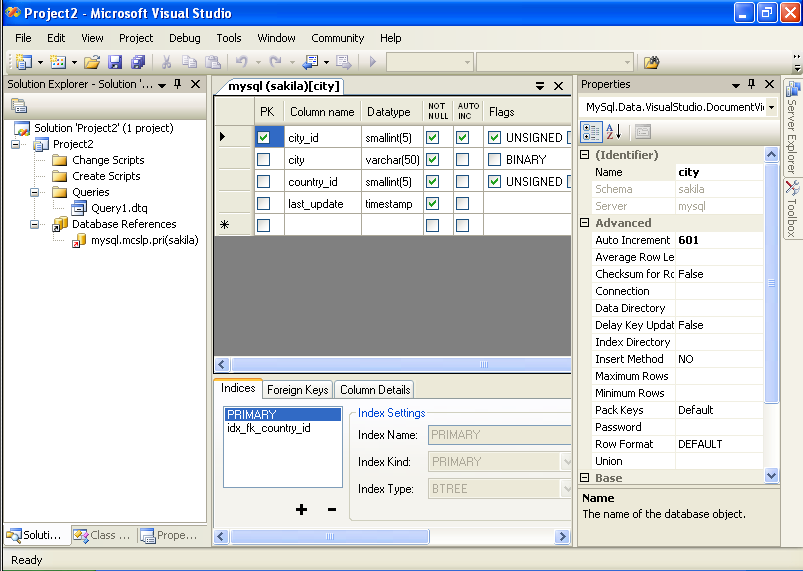- 20.3.3 Using the MySQL Visual Studio Plugin
- 20.3.3.1 Editing Tables
- 20.3.3.2 Editing Table Data
- 20.3.3.3 Editing Views
- 20.3.3.4 Editing Stored Procedures and Functions
- 20.3.3.5 Editing Triggers
- 20.3.3.6 Editing User Defined Functions (UDF)
- 20.3.3.7 Dropping database objects
- 20.3.3.8 Cloning database objects
[+/-]
The Table Editor can be accessed through a mouse action on table-type node of Server Explorer. To create a new table, right click on the Tables node (under the connection node) and choose the Create Table command from a context menu. To modify an existing table, double click on a node of the table you wish to modify, or right click on this node and choose the Alter Table command from a context menu. Either of the commands opens the Table Editor.

The MySQL Visual Studio Plugin Table Editor is implemented in a similar fashion to the standard Query Browser Table Editor, but with minor differences.
The Table Editor consists of the following parts:
Columns Editor — for column creation, modification and deletion.
Indexes tab — for table/column index management.
Foreign Keys tab — for configuration of foreign keys.
Column Details tab — used to set advanced column options.
Properties window — used to set table properties.
To save changes you have made in the Table Editor, use either Save or Save All buttons of the Visual Studio main toolbar, or just press Ctrl+S. Before changes are saved, a confirmation dialog will be displayed to confirm that you want to update the corresponding object within the MySQL database.
You can use the Column Editor to set or change the name, data type, default value and other properties of a table column. To set the properties of an individual column, select the column using the mouse. Alternatively, you can move through the grid using Tab and Shift+Tab keys.
To set or change the name, data type, default value and comment of a column, select the appropriate cell and edit the desired value.
To set or unset flag-type column properties (for example, primary key,
NOT NULL, auto-incremented, flags), check or uncheck the corresponding checkboxes. Note that the available column flags will depend on the columns data type.To reorder columns, index columns or foreign key columns in the Column Editor, select the whole column you wish to reorder by clicking on the selector column at the left of the column grid. Then move the column by using Ctrl+Up (to move the column up) and Ctrl+Down (to move the column down) keys.
To delete a column, select it by clicking on the selector column at the left of the column grid, then press the Delete button on a keyboard.
Index management is performed via the Indexes tab.
To add an index, press the + button and set the properties in the Index Settings groupbox at the right. You can set the index name, index kind, index type and a set of index columns.
To remove an index, select the index from the list and press the - button.
To change index settings, select the index from the list; detailed information about the index is displayed in the Index Settings panel.
You cannot change a table column to an index column using drag and drop. Instead, you can add new index columns to a table and set their table columns by using the embedded editor within the Indexes tab
Foreign Key management is performed via the Foreign Keys tab.
To add a foreign key, press the + button and set properties in the Foreign Keys Settings panel. You can set the foreign key name, referenced table name, foreign key columns and actions on update and delete.
To remove a foreign key, select the foreign key and press the - button.
To change foreign key settings, select the foreign key and use the Foreign Keys Settings panel to edit the properties.
When a foreign key is changed, the MySQL Visual Studio Plugin generates two queries: the first query drops the changed keys and the second one recreates the new values. The reason for such a behavior is to avoid the Bug#8377 and Bug#8919.
Note
If changed values are for some reason inconsistent and cause the second query to fail, all affected foreign keys will be dropped. If this is the case, the MySQL Visual Studio Plugin will mark them as new in the Table Editor, and you will have to recreate them later. But if you close the Table Editor without saving, these foreign keys will be lost.
The Column Details tab can be used to set column options. Besides the main column properties that are presented in the Column Editor, in the Column Details tab you can set two additional properties options: the character set and the collation sequence.
There is no separate tab for table options and advanced options. All table options can be browsed and changed using the Properties window of Visual Studio 2005.
The following table properties can be set:
Auto Increment
Average Row Length
Character Set
Checksum for Rows
Collation
Comment
Connection
Data Directory
Delay Key Updates
Engine
Index Directory
Insert Method
Maximum Rows
Minimum Rows
Name
Pack Keys
Password
Row Format
Union
Some of these properties can have arbitrary text values, others accept values from a predefined set.
The properties Schema and Server are read only.

User Comments
Add your own comment.